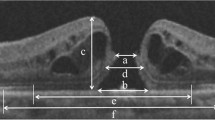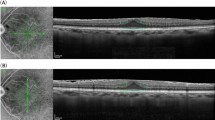Abstract
Purpose
To investigate stereopsis and other visual functions in patients with unilateral epiretinal membrane (ERM) and to identify vision-related parameters affecting stereopsis.
Methods
This prospective study included 63 consecutive patients who were scheduled to undergo vitrectomy for unilateral idiopathic ERM. We examined stereopsis (Titmus Stereo Test, TST; TNO stereotest, TNO), best-corrected visual acuity (BCVA), letter contrast sensitivity, severity of metamorphopsia, and degree of aniseikonia preoperatively and 6 months postoperatively.
Results
Preoperatively, we observed significant correlation between TST scores and other vision-related parameters except severity of metamorphopsia and between TNO score and all the vision-related parameters. Multiple regression analysis showed that preoperative TST and TNO scores were significantly associated with the degree of aniseikonia (both P < 0.01). ERM surgery significantly improved stereopsis, BCVA, contrast sensitivity, and metamorphopsia, but not aniseikonia. Postoperatively, TST was significantly associated with BCVA, and TNO showed association with BCVA and aniseikonia. Postoperative TST and TNO scores showed significant correlation with preoperative aniseikonia (P < 0.005 and P < 0.001, respectively).
Conclusions
Impairment of stereopsis in patients with unilateral ERM was considered to be due to retinally induced aniseikonia. Aniseikonia did not improve by surgery, and preoperative aniseikonia can be a prognostic factor for postoperative stereopsis.



Similar content being viewed by others
References
Wheatstone C (1838) Contributions to the physiology of vision.—part the first. On some remarkable and hitherto unobserved phenomena of binocular vision. Philos Trans R Soc Lond Ser B Biol Sci 128:371–394
Lam AK, Chau AS, Lam WY et al (1996) Effect of naturally occurring visual acuity differences between two eyes in stereoacuity. Ophthalmic Physiol Opt 16:189–195
Donzis PB, Rappazzo JA, Burde RM, Gordon M (1983) Effect of binocular variations of Snellen's visual acuity on Titmus stereoacuity. Arch Ophthalmol 101:930–932
Larson WL, Bolduc M (1991) Effect of induced blur on visual acuity and stereoacuity. Optom Vis Sci 68:294–298
Levy NS, Glick EB (1974) Stereoscopic perception and Snellen visual acuity. Am J Ophthalmol 78:722–724
Goodwin RT, Romano PE (1985) Stereoacuity degradation by experimental and real monocular and binocular amblyopia. Invest Ophthalmol Vis Sci 26:917–923
Erickson P, McGill EC (1992) Role of visual acuity, stereoacuity, and ocular dominance in monovision patient success. Optom Vis Sci 69:761–764
Katsumi O, Tanino T, Hirose T (1986) Effect of aniseikonia on binocular function. Invest Ophthalmol Vis Sci 27:601–604
Lovasik JV, Szymkiw M (1985) Effects of aniseikonia, anisometropia, accommodation, retinal illuminance, and pupil size on stereopsis. Invest Ophthalmol Vis Sci 26:741–750
Pierce DM (1975) Comparability of two methods of estimating real-depth acuity. Ophthalmologica 171:224–235
Weinman J, Cooke V (1982) Eye dominance and stereopsis. Perception 11:207–210
Kani W (1978) Stereopsis and spatial perception in amblyopes and uncorrected ametropes. Br J Ophthalmol 62:756–762
Watanabe A, Arimoto S, Nishi O (2009) Correlation between metamorphopsia and epiretinal membrane optical coherence tomography findings. Ophthalmology 116:1788–1793
Bae SH, Kim D, Park TK et al (2013) Preferential hyperacuity perimeter and prognostic factors for metamorphopsia after idiopathic epiretinal membrane surgery. Am J Ophthalmol 155:109–117
Okamoto F, Sugiura Y, Okamoto Y et al (2012) Associations between metamorphopsia and foveal microstructure in patients with epiretinal membrane. Invest Ophthalmol Vis Sci 53:6770–6775
Kinoshita T, Imaizumi H, Okushiba U et al (2012) Time course of changes in metamorphopsia, visual acuity, and OCT parameters after successful epiretinal membrane surgery. Invest Ophthalmol Vis Sci 53:3592–3597
Ooto S, Hangai M, Takayama K et al (2011) High-resolution imaging of the photoreceptor layer in epiretinal membrane using adaptive optics scanning laser ophthalmoscopy. Ophthalmology 2011(118):873–881
Matsumoto C, Arimura E, Okuyama S et al (2003) Quantification of metamorphopsia in patients with epiretinal membranes. Invest Ophthalmol Vis Sci 44:4012–4016
Arimura E, Matsumoto C, Okuyama S et al (2005) Retinal contraction and metamorphopsia scores in eyes with idiopathic epiretinal membrane. Invest Ophthalmol Vis Sci 46:2961–2966
Okamoto F, Sugiura Y, Okamoto Y et al (2014) Time course of changes in aniseikonia and foveal microstructure after vitrectomy for epiretinal membrane. Ophthalmology 121:2255–2260
Okamoto F, Sugiura Y, Okamoto Y et al (2017) Aniseikonia in various retinal disorders. Graefes Arch Clin Exp Ophthalmol 255:1063–1071
Moon BG, Yang YS, Chung H, Sohn J (2019) Correlation between macular microstructures and aniseikonia after idiopathic epiretinal membrane removal. Retina. https://doi.org/10.1097/IAE.0000000000002530 [Epub ahead of print]
Tanikawa A, Shimada Y, Horiguchi M (2018) Comparison of visual acuity, metamorphopsia, and aniseikonia in patients with an idiopathic epiretinal membrane. Jpn J Ophthalmol 62:280–285
Hirata A, Nakada H, Mine K et al (2019) Relationship between the morphology of the foveal avascular zone and the degree of aniseikonia before and after vitrectomy in patients with unilateral epiretinal membrane. Graefes Arch Clin Exp Ophthalmol 257:507–515
Ichikawa Y, Imamura Y, Ishida M (2018) Associations of aniseikonia with metamorphopsia and retinal displacements after epiretinal membrane surgery. Eye (Lond) 32:400–405
Takabatake M, Higashide T, Udagawa S, Sugiyama K (2018) Postoperative changes and prognostic factors of visual acuity, metamorphopsia, and aniseikonia after vitrectomy for epiretinal membrane. Retina 38:2118–2127
Sugiura Y, Okamoto F, Okamoto Y et al (2014) Contrast sensitivity and foveal microstructure following vitrectomy for epiretinal membrane. Invest Ophthalmol Vis Sci 55:7594–7600
Bouwens MD, Meurs JC (2003) Sine Amsler Charts: a new method for the follow-up of metamorphopsia in patients undergoing macular pucker surgery. Graefes Arch Clin Exp Ophthalmol 241:89–93
Wong JG, Sachdev N, Beaumont PE, Chang AA (2005) Visual outcomes following vitrectomy and peeling of epiretinal membrane. Clin Exp Ophthalmol 33:373–378
Asaria R, Garnham L, Gregor ZJ, Sloper JJ (2008) A prospective study of binocular visual function before and after successful surgery to remove a unilateral epiretinal membrane. Ophthalmology 115:1930–1937
Okamoto F, Sugiura Y, Okamoto Y et al (2015) Stereopsis and optical coherence tomography findings after epiretinal membrane surgery. Retina 35:1415–1421
Hikichi T, Onodera A, Ishiko S et al (2001) Stereo acuity in patients with unilateral macular hole and after unilateral macular hole surgery. Graefes Arch Clin Exp Ophthalmol 239:128–132
Mireskandari K, Garnham L, Sheard R et al (2004) A prospective study of the effect of a unilateral macular hole on sensory and motor binocular function and recovery following successful surgery. Br J Ophthalmol 88:1320–1324
Watanabe H, Okamoto F, Sugiura Y et al (2014) Stereopsis after successful surgery for rhegmatogenous retinal detachment. Graefes Arch Clin Exp Ophthalmol 252:1207–1212
Chylack LT Jr, Wolfe JK, Singer DM et al (1993) The Lens opacities classification system III. The longitudinal study of cataract study group. Arch Ophthalmol 111:831–836
Katsumi O, Miyanaga Y, Hirose T et al (1988) Binocular function in unilateral aphakia. Correlation with aniseikonia and stereoacuity. Ophthalmology 95:1088–1093
Shimada H, Nakashizuka H, Hattori T et al (2009) Double staining with brilliant blue G and double peeling for epiretinal membranes. Ophthalmology 116:1370–1376
Okamoto F, Sugiura Y, Moriya Y et al (2016) Aniseikonia and foveal microstructure in patients with idiopathic macular hole. Ophthalmology 123:1926–1932
Benegas NM, Egbert J, Engel WK, Kushner BJ (1999) Diplopia secondary to aniseikonia associated with macular disease. Arch Ophthalmol 117:896–899
Brooks SE, Johnson D, Fischer N (1996) Anisometropia and binocularity. Ophthalmology 103:1139–1143
de Wit GC (2008) Clinical usefulness of the aniseikonia inspector: a review. Binocul Vis Strabismus Q 23:207–214
de Wit GC, Muraki CS (2006) Field-dependent aniseikonia associated with an epiretinal membrane a case study. Ophthalmology 113:58–62
Ugarte M, Williamson TH (2005) Aniseikonia associated with epiretinal membranes. Br J Ophthalmol 89:1576–1580
Berens C, Bannon RE (1963) Aniseikonia: a present appraisal and some practical considerations. Arch Ophthalmol 70:181–188
Kramer PW, Lubkin V, Pavlica M, Covin R (1999) Symptomatic aniseikonia in unilateral and bilateral pseudophakia. A projection space eikonometer study. Binocul Vis Strabismus Q 14:183–190
Pesin SR, Olk RJ, Grand MG et al (1991) Vitrectomy for premacular fibroplasia: prognostic factors, long-term follow-up, and time course of visual improvement. Ophthalmology 98:1109–1114
Sjöstrand J, Anderson C (1986) Micropsia and metamorphopsia in the re-attached macula following retinal detachment. Acta Ophthalmol 64:425–432
Author information
Authors and Affiliations
Corresponding author
Ethics declarations
Conflict of interest
The authors declare that they have no conflicts of interest.
Ethical approval
We conducted this prospective comparative study in accordance with the Declaration of Helsinki and received approval from the institutional review committees of the University of Tsukuba Hospital. Prior to enrollment in the study, all patients provided informed consent after the nature of the study was explained (On line 69–72 of the manuscript).
Additional information
Publisher’s note
Springer Nature remains neutral with regard to jurisdictional claims in published maps and institutional affiliations.
Rights and permissions
About this article
Cite this article
Okamoto, F., Morikawa, S., Sugiura, Y. et al. Preoperative aniseikonia is a prognostic factor for postoperative stereopsis in patients with unilateral epiretinal membrane. Graefes Arch Clin Exp Ophthalmol 258, 743–749 (2020). https://doi.org/10.1007/s00417-020-04625-8
Received:
Revised:
Accepted:
Published:
Issue Date:
DOI: https://doi.org/10.1007/s00417-020-04625-8




